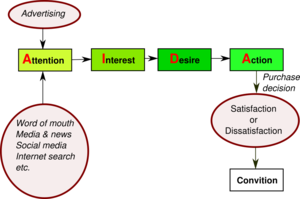AIDA model
| AIDA model |
|---|
| See also |
AIDA model shows how the impact of advertising on consumers. It also presents and explains the psychological basis of its actions. Advertising should attract the attention of a potential customer, who should notice it among others ads or sources of information. Then, consumer should take interest in the product and focus on its main aspects (features, benefits from use, etc.). The last elements of the AIDA model is influencing the customer's desire to own the product and cause that he will react on advertising and purchase.
This formula was established in 1925 by EK Strong, and is today used as a basic model, according to which advertising is developed. A (Attention) – attract attention I (interest) - arouse interest D (desire) - create the desire to have the product A (action) - incline to purchase An example of the splitting of a 30-second TV spot according do the mode: A (5 sec) attract attention, I (10 sec.) dramatization / presentation, D (10 sec.) message indicating benefits, A (5 sec.) slogan / source of additional information about purchase.
Consumer reactions
AIDA model assumes four consecutive reactions of the consumer, whose first letters are indicated by the acronym AIDA:
- A - Attention
The first stage of the reaction of the recipient of the marketing message is to draw attention to the product or offering. Effective advertising message is therefore geared primarily to stick in the minds of consumers and then to attract interest of the largest possible number of them influencing move to the next stage. Marketers must guess the needs and interests of the potential consumer and build the marketing message according to it.
- I - Interest
The next step is to arouse interest in the product, its properties and benefits to be achieved through the purchase. The potential customer is ready to make efforts to find additional information about the interesting product which allow marketer to create the desire of ownership in the mind of the customer.
- D - desire
Generating the desire to take advantage of the offer presented in the marketing communication is the next step in the AIDA model. The consumer receiving the message has to be convinced that only this product best meets his need. When this desire arises, then the customer will look for ways to implement it (satisfy his needs).
- A - Action
Final action taken by the recipient of marketing message in response to effective communication. Convincing consumers to purchase a product or service and his determination to achieve his felt desire is crucial to the succes.
Enhanced AIDA model
AIDA model can be enhanced by two additional stages, and take form of AIDACS model. These two additional stages take place after the action stage (purchase of product or service). They are:
- C - Conviction
This stage involves creating the customer belief that he made the right choice and made the right decision by buying the product offered. Thanks to this, consumer is convinced that the chosen product will satisfy his needs and matches his preferences.
- S - Satisfaction
The induction of long-term customer satisfaction is a key element to avoid possible dissonance felt after purchasing the product. Satisfaction contribute to additional purchase or recommending of advertised product to friends and family thanks to the so-called. word of mouth marketing or whisper marketing.
See also:
- EBK model
- Bettman model
- Nicosia model of consumer behaviour
- Howard Sheth model of consumer behaviour
- Consumer decision making process
References
- Engel J.F., Kollat D.T., Blackwell R.D., Consumer Behaviour, Holt, Reinhart & Winston, New York 1968, s. 32.
- Ghirvu, A. I. (2013). The AIDA model for AdverGames. The USV Annals of Economics and Public Administration, 13(1 (17)), 90-98.
- Foxall, G. R., Oliveira-Castro, J. M., James, V. K., & Schrezenmaier, T. C. (2011). Consumer behaviour analysis and the behavioural perspective model. Management Online Review (MORE).
- Kandasamy, C. (2015). Models of Consumer Behaviour - a Study. Asia Pacific Journal of Research Vol: I. Issue XXIX.
- Kollat, D. T., Engel J. F., & Blackwell, R. D. (1970). Current problems in consumer behavior research. Journal of Marketing Research, 327-332.
Author: Krzysztof Wozniak
